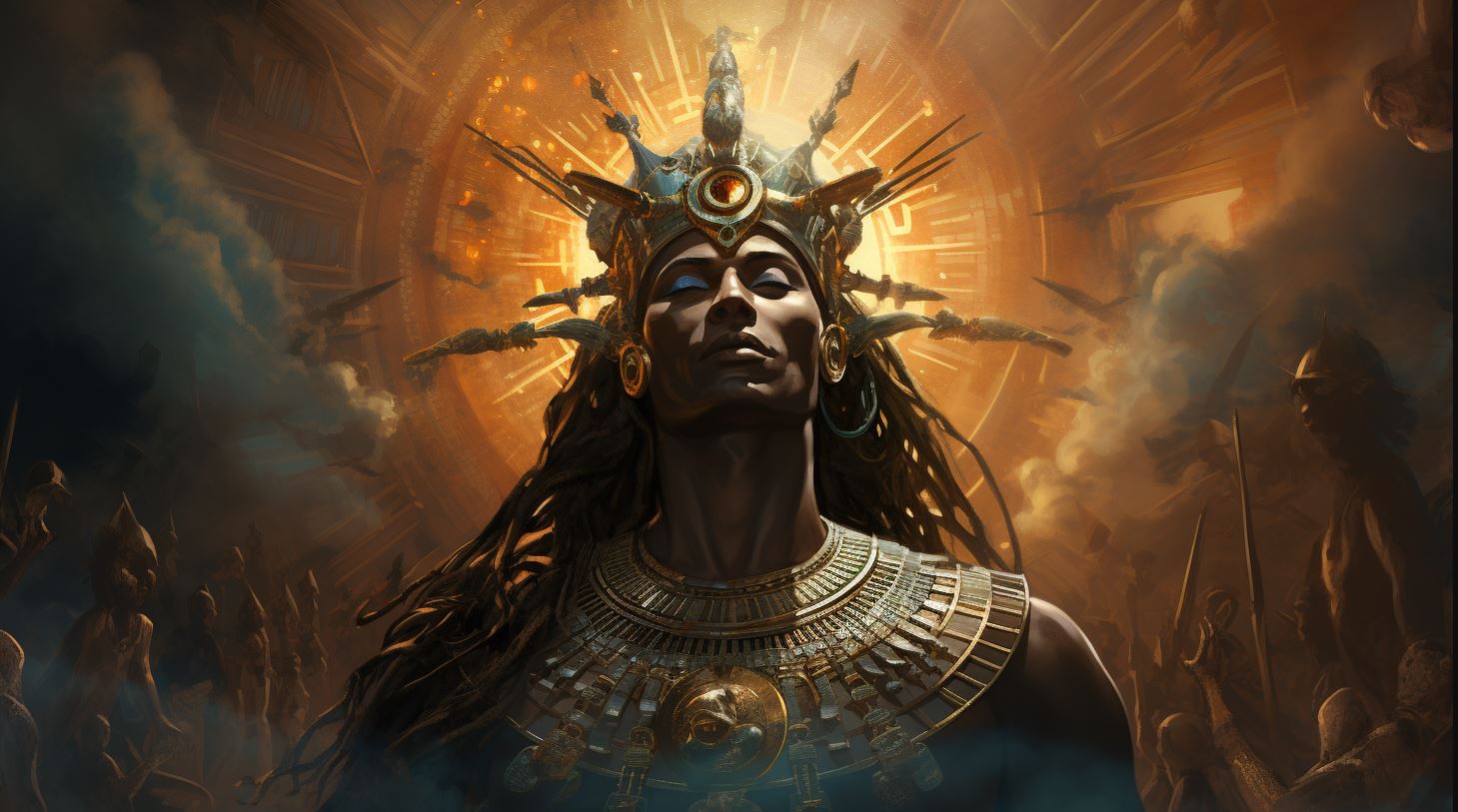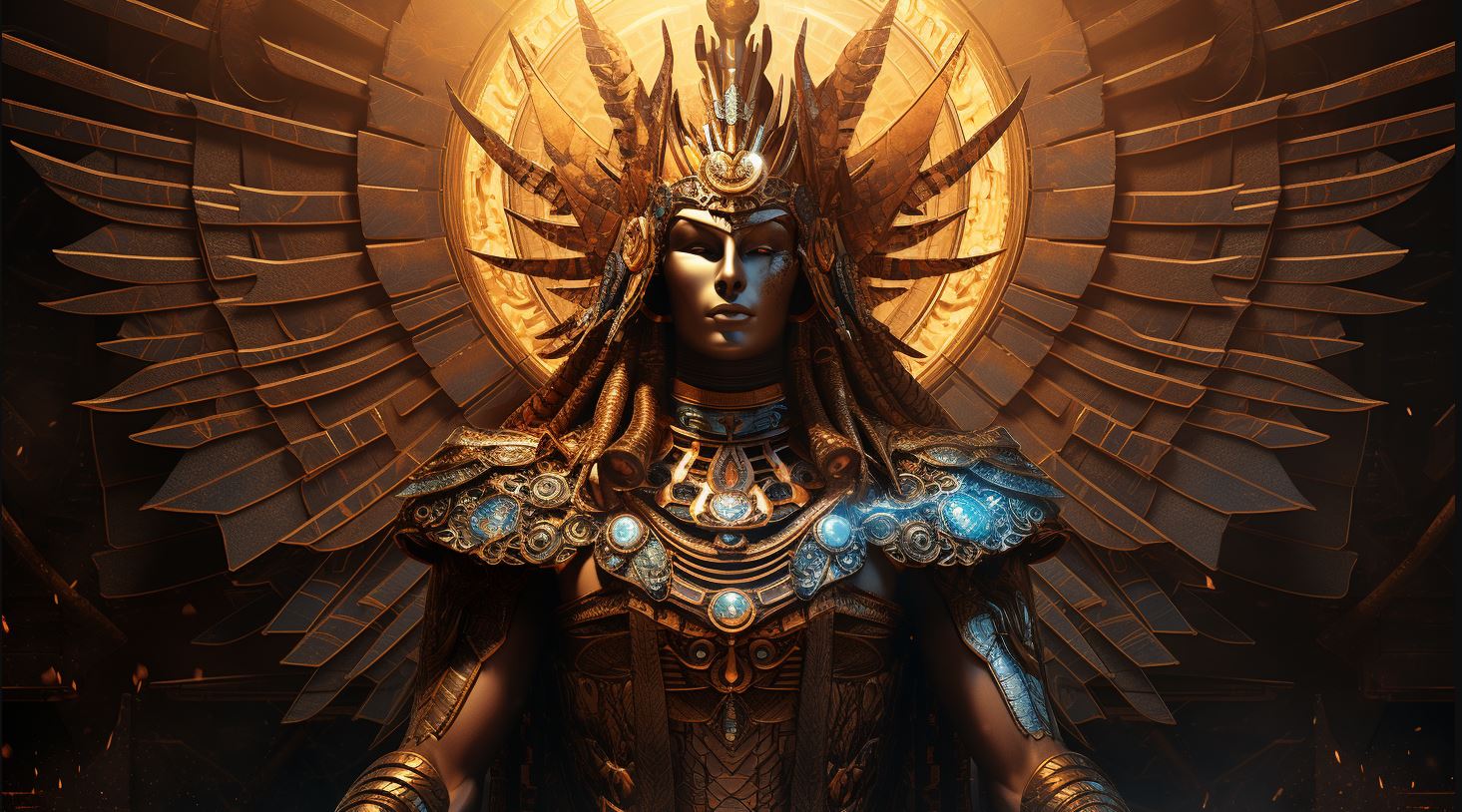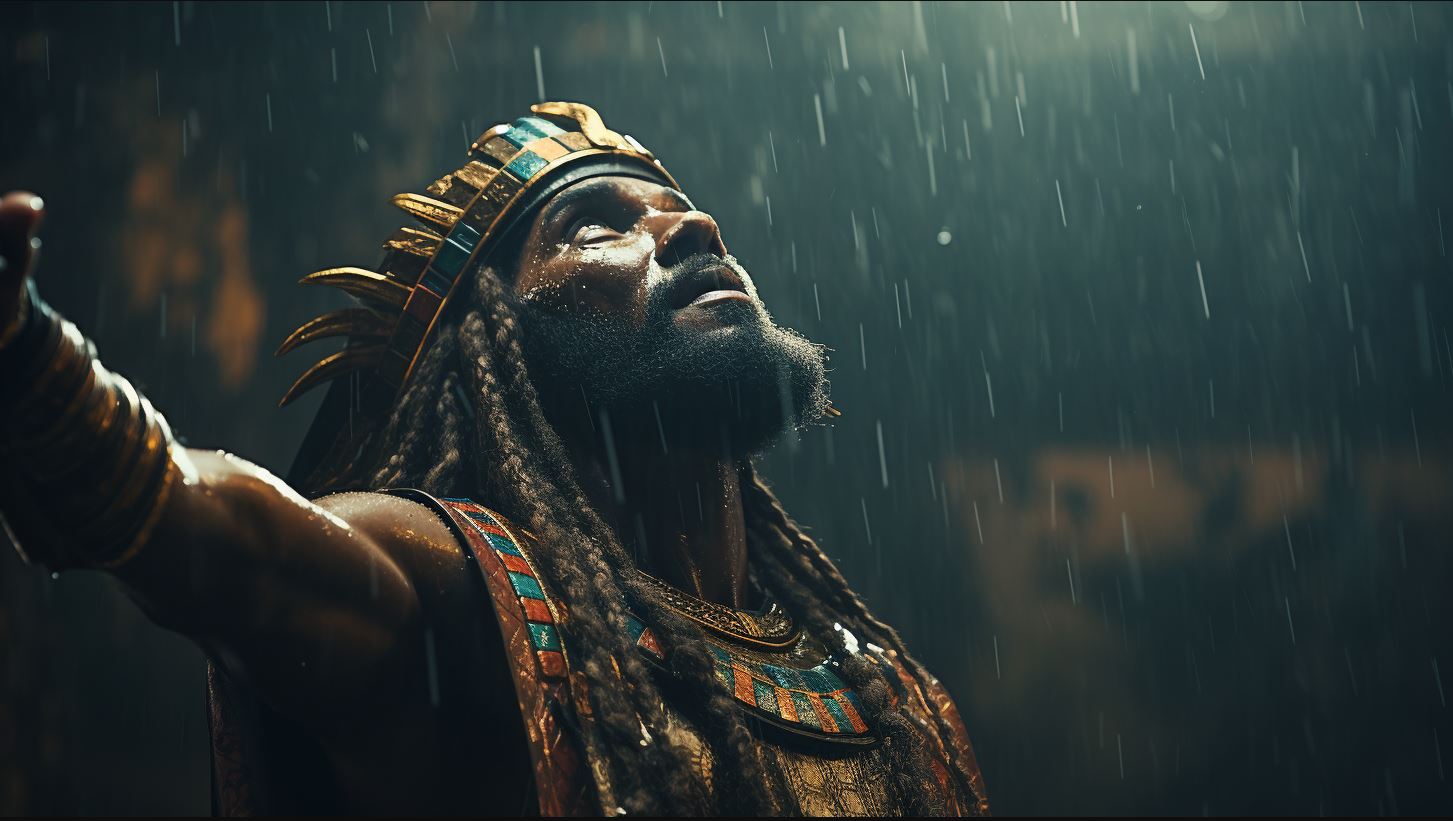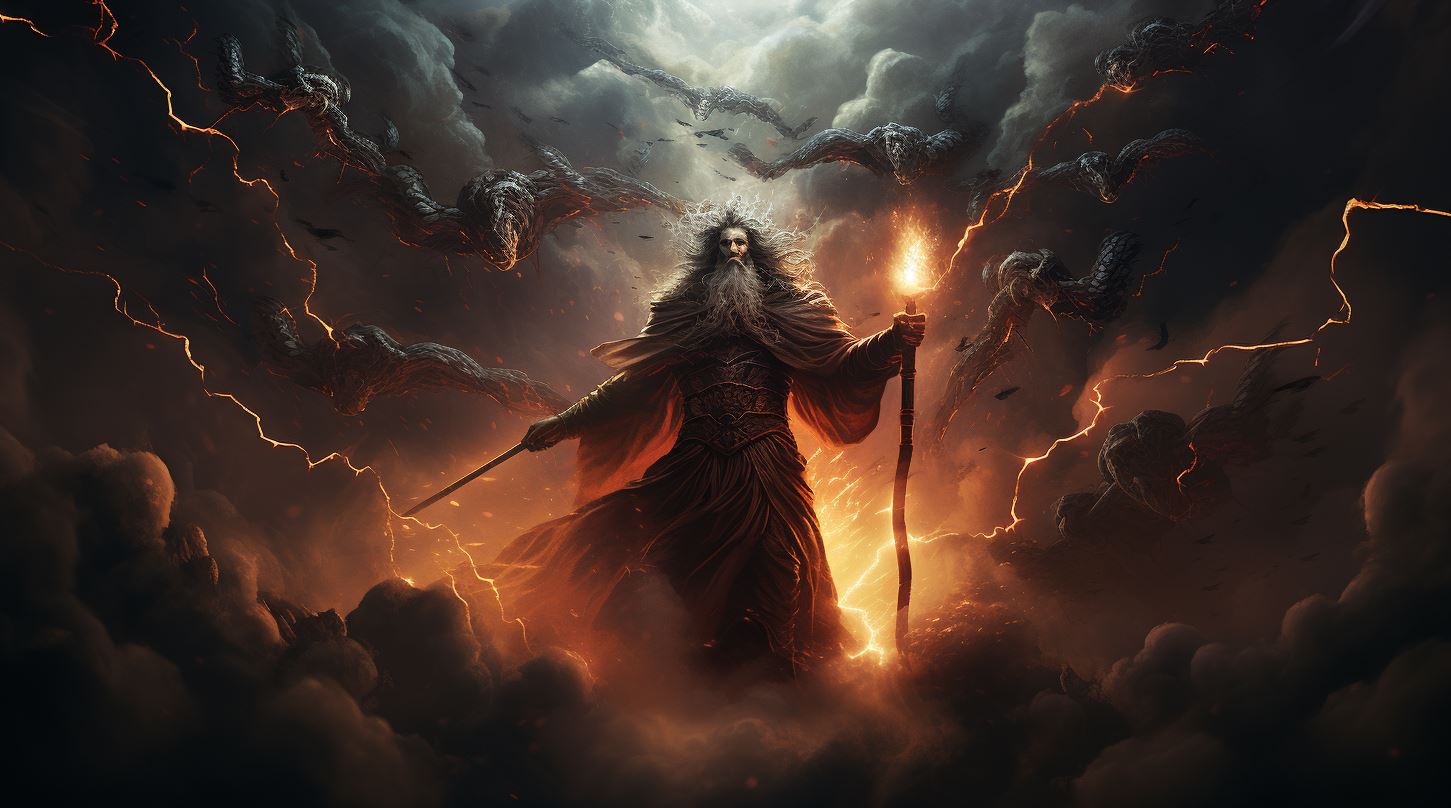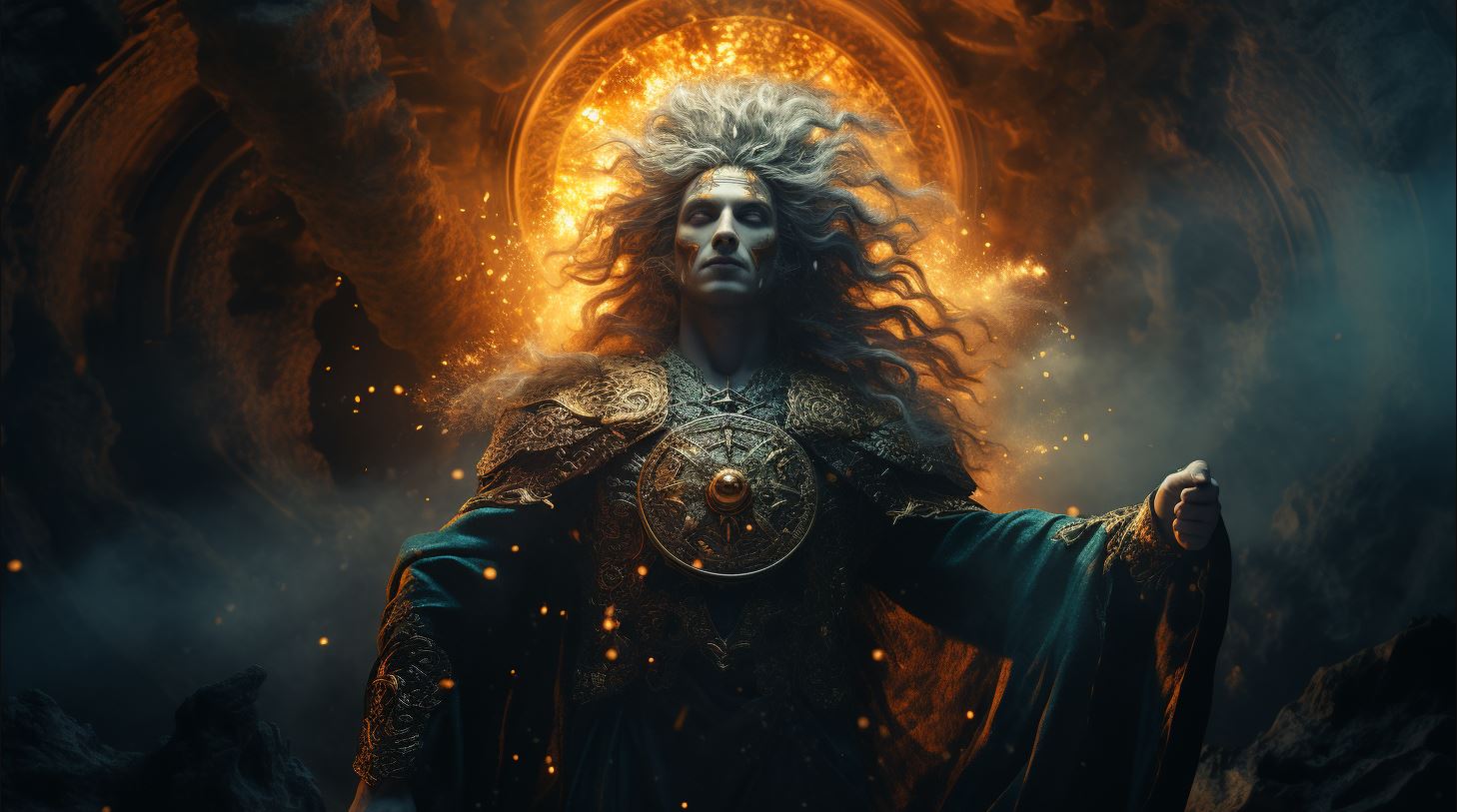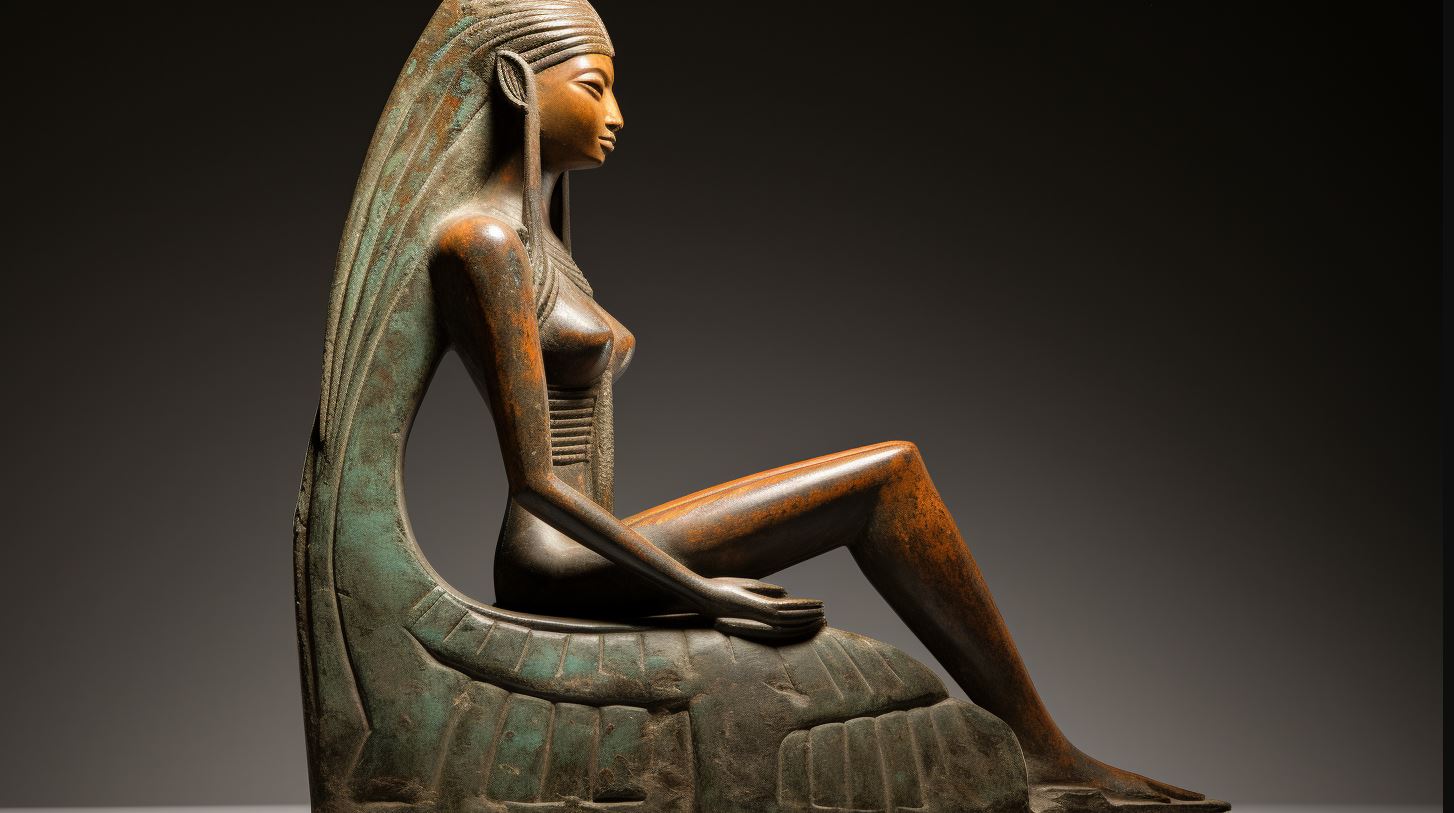El The Canaanite God: Unveiling the Supreme Deity of Ancient Canaanite Religion

Canaanite mythology revolves around the deity known as El, the supreme god in ancient Canaanite religion. El is associated with various other gods like Asherah, Anat, Baal, and Yahweh, and his influence extends beyond Canaan to civilizations in Anatolia, Arabia, Egypt, Iran, Mesopotamia, and Syria.
Represented as an elderly figure with a long beard, El is revered as the god of eternity and plays a significant role in the pantheon of ancient Near Eastern gods.
This article explores El’s prominence, relationships, and his portrayal in ancient texts.
Stay tuned as we delve deeper into the enigmatic Canaanite god.
Canaanite Mythology and the God El
In the fascinating realm of Canaanite mythology, one deity stands above all others as the focal point of worship – El, the supreme god. This divine figure, depicted as an elderly man with a flowing beard, holds immense significance in the ancient Canaanite religion.
El’s role as a divine being extends beyond Canaan, with his presence being recognized in various civilizations and cultures spanning Anatolia, Arabia, Egypt, Iran, Mesopotamia, and Syria. His influence transcends borders, showcasing the widespread reverence for this powerful god.
Within the Canaanite pantheon, El is intricately intertwined with other deities such as Asherah, Anat, Baal, and Yahweh. These relationships shed light on the complex dynamics of the ancient Canaanite belief system and the intricate interplay between these divine entities.
Exploring Canaanite mythology provides a window into a rich tapestry of ancient beliefs and practices, offering insights into the pantheon of gods, their roles, and the significance of El as the pinnacle of divine authority.
Join us in delving deeper into the mythological realm of the Canaanite god El as we unravel the mysteries and legacies of this ancient religion.
Linguistic Forms and Meanings of El in Ancient Canaanite Religion
In the ancient Canaanite religion, the god El is represented through various linguistic forms and holds distinct meanings within the religious context.
El is not only a proper name but also functions as a generic term for deity in Semitic languages, particularly among the Semitic peoples of the Western region. While El’s name itself signifies “god” or “deity,” it conveys a sense of authority and power, establishing El as the supreme god in Canaanite mythology.
The diverse epithets and titles associated with El, such as “Father Bull,” “Creator of Creatures,” and “Kindly El,” reflect different aspects of his divine nature. These linguistic expressions emphasize El’s role as the creator, protector, and provider to his worshippers, illustrating his benevolence and wisdom as the most revered god in Canaanite religion.
Furthermore, El’s name is frequently mentioned alongside other Canaanite deities, highlighting the interconnectedness of these gods within the religious pantheon. These associations contribute to El’s significance as the head of the divine assembly and further illustrate his role as the ultimate authority in the ancient Canaanite belief system.
In Canaanite mythology, the god El is intimately connected with various other deities who are considered to be associated with him. One such deity is Asherah, often depicted as El’s consort and associated with fertility and motherhood.
Asherah is revered as a prominent goddess in Canaanite religion, and her worship is often intertwined with that of El.
Another significant deity associated with El is Anat, the goddess of war and hunting. Anat holds a fierce and independent nature, often depicted as a mighty warrior.
She represents the strength and power associated with El, serving as a symbol of his authority in the realm of battle and victory.
Alongside Asherah and Anat, there exist a multitude of other divine beings connected to El. These deities include Yahweh, Baal, Mot, Yam, Shahar, Shapash, Shalim, and more.
Each deity brings forth unique attributes and roles within the Canaanite pantheon, amplifying the diversity and complexity of El’s divine presence.
The interconnections and relationships between El and these associated deities offer fascinating insights into the religious beliefs and practices of the ancient Canaanites. Exploring the roles and significance of Asherah, Anat, and other associated deities within the context of El’s worship deepens our understanding of Canaanite mythology and the multifaceted nature of their divine hierarchy.
El’s Presence in Civilizations and Cultures Beyond Canaan
El, the supreme god of ancient Canaan, transcended the borders of Canaanite religion and left a lasting influence on various civilizations and cultures beyond the Canaanite realm.
Anatolia, Arabia, Egypt, Iran, Mesopotamia, and Syria are among the regions that encountered the presence of El and integrated elements of his worship into their own religious practices.
El’s wide-ranging impact is a testament to the significance and reverence accorded to this deity.
While the exact nature of El’s adaptation and assimilation into different cultures varies, his veneration as a divine figure remained consistently prominent.
Whether as the primary god or as part of a larger pantheon, El found his place among the deities of different civilizations, influencing their mythologies, rituals, and religious conceptions.
El’s connections to other prominent deities such as Baal, Anat, and Asherah fostered a network of divine interactions and further solidified his presence in religious narratives.
The exchange of religious ideas and deities like El reshaped belief systems, enriching the tapestry of ancient cultures and laying the foundation for future developments in religious thought.
The Relationship between El and Baal: Conquest of the Sea
In Canaanite mythology, El and Baal share a complex and interconnected relationship.
One notable tale involves Baal’s conquest over the sea, which plays a significant role in understanding their connection.
According to ancient texts, Baal challenged Yamm, the god of the sea, for dominion over the Earth’s waters. In this fierce battle, Baal emerged victorious, defeating Yamm and establishing his authority over the sea.
This conquest not only showcases Baal’s power but also highlights the role of El in supporting Baal’s claim to supremacy. As the supreme god, El played a crucial role in legitimizing Baal’s victory and endorsing his authority over the sea and other natural elements.
The conquest of the sea by Baal symbolizes his triumph over chaos and his ability to maintain order in the world.
This legendary tale demonstrates the power dynamics within the Canaanite pantheon and the intertwined nature of divine authority. The relationship between El and Baal exemplifies the dynamics between the supreme god and other deities, with El serving as a divine patron to Baal and endorsing his actions and conquests.
Understanding this relationship provides valuable insights into the roles and interactions of deities within Canaanite mythology.
El and Yahweh: Exploring the Connection
One fascinating aspect of Canaanite mythology is the relationship between El and Yahweh, the god worshipped by the ancient Israelites. Scholars have long debated the connection between these two deities and the influence they had on each other.
While El is considered the supreme god in Canaanite religion, Yahweh emerges as the central deity in Israelite religious texts. The crucial question lies in understanding how these two entities interacted and potentially merged over time.
Some scholars suggest that Yahweh may have originated as a regional warrior god associated with the southern regions of Canaan, later becoming more prominent and absorbing attributes associated with El. This development could signify the melding of Canaanite and Israelite religious beliefs.
Exploring the connection between El and Yahweh sheds light on the religious and cultural exchange between ancient Canaanite and Israelite communities. It offers insights into the complex nature of religious development and the shared roots of these traditions.
The Representation of El in Ancient Texts, including the Hebrew Bible
Ancient texts, including the Hebrew Bible, provide insightful glimpses into the representation of El, the Canaanite god, and his significance in Canaanite religion.
El is often portrayed as a powerful and venerable deity, symbolizing wisdom and authority. In the Hebrew Bible, El is mentioned as a generic term for deity and also used interchangeably with Yahweh, emphasizing his status as the supreme god.
Within the context of ancient texts, El is depicted as an influential figure in the divine pantheon, presiding over the other gods and goddesses. His portrayal as an elderly man with a long beard signifies his wisdom and timeless existence.
These texts highlight the integral role of El in the religious beliefs and practices of ancient Canaanites.
Furthermore, the Hebrew Bible presents narratives depicting the relationship between El and other deities, particularly Baal. These accounts often showcase conflicts and power struggles between the gods, highlighting the conquest of Baal over the sea and his triumph over rival deities.
Studying the representation of El in ancient texts allows us to delve deeper into the religious and cultural landscape of the Canaanites. It provides valuable insights into their beliefs, rituals, and the significance of El as the supreme deity in their cosmology.
The Veneration of El as the Supreme God in Canaanite Religion
In the ancient Canaanite religion, El holds a revered status as the supreme god. He is highly esteemed and worshipped by the Canaanite people as the ruler of the gods and the divine father figure.
El’s veneration stems from his association with qualities like wisdom, authority, and eternal existence. As the highest deity in the Canaanite pantheon, El is believed to govern the natural world, control the destinies of individuals and nations, and oversee cosmic affairs.
El’s significance as the supreme god is also evident in his portrayal as an elderly figure with a long beard, symbolizing his wisdom and timelessness. The Canaanites offer prayers, sacrifices, and rituals to honor El and seek his favor.
His worship often involves elaborate ceremonies held at sacred places, where priests and devotees gather to express their devotion and seek divine guidance.
The veneration of El as the supreme god in Canaanite religion is deeply ingrained in the cultural and religious fabric of the ancient Canaanite society.
His position as the divine ruler and protector of the people provides a sense of comfort and assurance. The worship of El not only reinforces the religious beliefs and practices of the Canaanites but also serves as a unifying force among the community.
As we delve deeper into the Canaanite pantheon, we gain a better understanding of the profound reverence and significance attributed to El as the supreme god. Exploring the veneration of El sheds light on the rich religious traditions and beliefs that shaped the lives of the ancient Canaanites.
El as a Venerable Old Man: Iconography and Symbolism
In Canaanite mythology, the god El is often depicted as a venerable old man with a long, flowing beard. This iconic representation symbolizes wisdom, authority, and the divine power associated with El.
As the supreme deity in the Canaanite pantheon, El’s portrayal as an elderly figure underscores his role as the wise and experienced ruler of the gods.
The use of this specific imagery of El as an elderly man aligns with the cultural perception of wisdom and respect that comes with age.
It emphasizes El’s position as the preeminent god, commanding reverence from his worshippers and other deities in the Canaanite religion.
This representation of El as an old man not only highlights his age and wisdom but also inspires a sense of awe and reverence in the minds of Canaanite devotees.
It serves as a visual reminder of El’s divine authority and the important cosmic role he plays.
Furthermore, the portrayal of El as an elderly figure signifies his connection to the cycles of life and the eternal nature attributed to him.
Just as the elderly are associated with the wisdom gained through long lives, El represents the everlasting essence of the divine, bridging the mortal and immortal realms.
In Canaanite art and iconography, the depiction of El as a venerable old man underscores his significance and contributes to the overall understanding of his divine attributes and position within the ancient Canaanite religious beliefs.
The Use of El as a Generic Term for Deity in Semitic Languages
Within Semitic languages, the term ‘El’ holds significant importance as a generic term for deity. Used across various Semitic cultures, ‘El’ refers to the concept of a supreme or divine being.
It transcends the specific Canaanite context and extends to civilizations such as Arabia, Mesopotamia, and Egypt.
This term, rooted in ancient Semitic languages, carries a universal understanding of a higher power.
‘El’ represents the notion of transcendence and power in the divine realm, encompassing the attributes associated with deities.
Characteristic of ‘El’ in Semitic Languages
- Universal representation of deity
- Symbolizes transcendence and power
- Shared concept across Semitic cultures
- Associated with divine attributes
In ancient texts, including the Hebrew Bible, ‘El’ is frequently used interchangeably with Yahweh and serves as a general reference to any deity.
This highlights the broad cultural understanding and the widespread usage of ‘El’ as a generic term for divinity in Semitic languages.
By examining the use of ‘El’ as a generic term for deity in Semitic languages, we gain insight into the common thread that unites ancient civilizations in their perception of the divine.
Unraveling the Etymology and Origins of El
The etymology and origins of the Canaanite god El have been subjects of great fascination and scholarly debate. Studying ancient texts and linguistic evidence, researchers have attempted to trace the roots of El to uncover his true origins.
The term “El” itself is believed to derive from the general Semitic languages, where it serves as a generic term for deity.
While the exact origins of El remain elusive, some theories suggest a connection with other ancient Near Eastern deities, such as the Mesopotamian god Enlil or the Hurrian god Kumarbi.
These connections, however, are speculative and require further investigation.
Another aspect that scholars explore is the possibility of El being assimilated from earlier Canaanite or West Semitic deities, or even being an indigenous Canaanite deity that rose to prominence.
Understanding El’s origins is crucial in unraveling the complex web of Canaanite mythology and the wider context of ancient Near Eastern religious beliefs.
By delving into linguistic research, comparative mythology, and archaeological findings, scholars continue to gather pieces of the puzzle surrounding the etymology and origins of El.
As new discoveries emerge, our understanding of this enigmatic Canaanite god continues to evolve, shedding light on the rich tapestry of ancient religious beliefs in the Near East.
Canaanite Mythology and its Influence on Christian Theology
Canaanite mythology holds a significant place in the study of Christian theology, revealing intriguing connections between the ancient Canaanite pantheon and elements found in early Christian beliefs.
The influence of Canaanite mythology on Christian theology can be observed through various parallels and similarities discovered in sacred texts and religious practices.
An examination of Canaanite mythology sheds light on the conceptualization of a supreme deity, the nature of divine beings, and the structure of the divine realm.
These insights greatly contribute to our understanding of the development and evolution of religious ideas in the ancient Near East, which influenced the religious landscape into which Christianity emerged.
Within Christian theology, the exploration of Canaanite mythology presents an opportunity to explore the continuity and transformation of religious concepts throughout history.
This examination encourages scholars and theologians to delve deeper into the multicultural tapestry from which Christianity emerged, enriching our understanding of the ancient world and its impact on modern religious thought.
By studying Canaanite mythology, we gain a deeper appreciation for the intricate interplay between cultures and the enduring threads that connect various religious traditions. This exploration allows us to explore the theological tapestry that lies beneath the surface of familiar religious narratives, broadening our perspective on the complexity and diversity of human religious experiences throughout history.
Comparative Analysis: El in Ugaritic Texts and the Hebrew Bible
One fascinating aspect of studying the Canaanite god El is the comparative analysis of his portrayal in Ugaritic texts and the Hebrew Bible. Both ancient sources provide crucial insights into the beliefs and worship practices surrounding El.
In Ugaritic texts, El is depicted as the head of the divine pantheon, revered as the father of the gods and the creator of the world. He exercises his authority through divine council meetings, where decisions regarding the fate of gods and humans are made.
In the Hebrew Bible, El often appears as a generic term for deity, used interchangeably with Yahweh. However, specific passages showcase El as an individual god, revered as the God of Abraham, Isaac, and Jacob.
These texts emphasize El’s role as a protector and provider for his chosen people.
Comparing the portrayal of El in both sets of texts offers valuable insights into the evolution and interpretation of his character.
It allows scholars to trace the continuity and divergence of Canaanite religious beliefs as they merged with Israelite traditions.
By examining the similarities and differences between Ugaritic texts and the Hebrew Bible, we gain a deeper understanding of the complex nature of El’s worship in ancient Canaan and its influence on the development of monotheism in the Israelite religious landscape.
Lesser-Known Canaanite Deities: Athtart, Hadad, and Others
Canaanite mythology encompasses a diverse pantheon of deities, and while much attention is given to the supreme god El, there are several lesser-known gods and goddesses worthy of exploration. Among them are Athtart and Hadad, who play significant roles in Canaanite religious narratives.
Athtart, also known as Astarte, is a prominent goddess associated with love, beauty, and fertility. She is often depicted with symbolic imagery such as the crescent moon and a lion.
The worship of Athtart was widespread across Canaan, and she held a vital position among the deities worshipped in the region.
Hadad, on the other hand, is a powerful god associated with storms, thunder, and rain.
He is often portrayed with a lightning bolt and a club, reflecting his role as a force of nature. Hadad’s influence was particularly significant in agricultural communities, as he was believed to control the weather patterns that affected harvests.
In addition to Athtart and Hadad, there are numerous other lesser-known Canaanite deities, each with their unique significance and role within the pantheon. While their names might not be as recognizable as El or Baal, they offer insights into the rich and complex religious beliefs of the ancient Canaanites.
Exploring the lesser-known Canaanite deities allows us to gain a deeper understanding of the complex religious practices and beliefs of the ancient Canaanite civilization, shedding light on the diverse pantheon that existed alongside the worship of El and other prominent gods.
El’s Role in the Pantheon of Ancient Near Eastern Gods
In the vast pantheon of ancient Near Eastern gods, El holds a distinguished position as a revered deity in Canaanite mythology. As the chief god, El commands respect and adoration from his fellow gods, governing various aspects of life and the cosmos.
El’s authority is not confined to Canaan alone; his influence extends to surrounding regions such as Anatolia, Arabia, Egypt, Iran, Mesopotamia, and Syria.
Within the pantheon, El maintains important relationships with other divine beings.
Notable among these connections is El’s association with Baal, which is illuminated through the epic tale of Baal’s conquest over the sea. These mythical narratives offer insights into the cosmological significance of El in ancient Near Eastern beliefs.
Furthermore, exploration of El’s role in the Hebrew Bible reveals intriguing connections and resonances with the later figure of Yahweh. El’s representation as an elderly figure with a long beard symbolizes wisdom and timeless existence, highlighting his position as a venerable and revered deity in Canaanite religious practices.
Understanding El’s role in the ancient Near Eastern pantheon deepens our appreciation for Canaanite mythology and its influence on neighboring cultures. By examining El’s relationships, iconography, and significance, we gain valuable insights into the complex tapestry of deities that shaped the religious landscape of the ancient Near East.
Understanding the Canaanite Concept of a Supreme God: Comparisons with Other Cultures
Within Canaanite mythology, the concept of a supreme god represented by El holds intriguing parallels and divergences when compared to other ancient cultures. Exploring these comparative aspects allows us to grasp a deeper understanding of the Canaanite deity and his significance in the ancient Near East.
- In Mesopotamia, the god Marduk assumes a similar position as the supreme deity, symbolizing the divine authority and power over other gods.
- In Egyptian mythology, Amun-Ra and Atum play comparable roles as the supreme gods associated with creation and rulership.
- Greek mythology recognizes Zeus as the king of gods, sharing common attributes with El in terms of wisdom and fatherly authority.
- The Vedic deity Varuna in ancient Indian culture reveals striking parallels to El’s role as the protector of cosmic order and enforcer of divine law.
These cross-cultural comparisons help us contextualize the centrality of a supreme god figure in the religious systems of the ancient world, showcasing both shared notions and distinct divine characteristics within respective mythologies.
Exploring the Significance of El in the Ancient Near East
The significance of El in the ancient Near East cannot be underestimated. As the highest deity in Canaanite mythology, El held a position of great prominence and reverence among the ancient civilizations of the region.
El’s role extended beyond the boundaries of Canaan, with his influence being observed in various cultures and civilizations such as Anatolia, Arabia, Egypt, Iran, Mesopotamia, and Syria. This widespread presence underscores the significance and far-reaching impact of El’s worship.
El’s association with other deities, such as Asherah, Anat, Baal, and Yahweh, further demonstrates his interconnectedness within the pantheon and religious narratives of the ancient Near East. The relationships between these deities provide valuable insights into the religious beliefs and practices of the Canaanite people.
Exploring El’s significance also sheds light on the broader cultural and historical context of the ancient Near East. By examining El’s representation in ancient texts, including the Hebrew Bible, we can gain a deeper understanding of the religious beliefs, rituals, and symbolism associated with this revered god.
Additionally, delving into the veneration of El as the supreme god in Canaanite religion illuminates the hierarchical structure of the pantheon and the central role that El played within it. Understanding El’s attributes and symbolism, such as his portrayal as an elderly figure with a long beard, provides further insights into his divine nature and the way in which he was worshipped.
By exploring the significance of El in the ancient Near East, we gain valuable insights into the religious, cultural, and historical aspects of Canaanite mythology and its broader influence on the region.
Challenges and Limitations in Studying the Canaanite God El
Exploring the Canaanite god El presents certain challenges and limitations due to the scarcity of available information and the passage of time. Researchers and scholars face several obstacles when delving into the study of this ancient deity.
Some of the significant challenges include:
- The fragmentary nature of Canaanite texts and inscriptions, resulting in incomplete understanding of El’s roles and attributes.
- The lack of extensive surviving Canaanite literature, making it difficult to piece together a comprehensive narrative surrounding El.
- The influence of neighboring cultures and their interactions with Canaanite religion, which can further complicate the interpretation of El’s prominence.
- The limited archaeological evidence related specifically to El, making it challenging to gather insights into worship practices and rituals dedicated to him.
- The absence of direct documentation from Canaanites themselves, as most surviving accounts come from distant cultures or later sources.
Despite these obstacles, researchers employ cross-cultural comparative approaches, linguistic analysis, and interdisciplinary studies to gain a deeper understanding of El and his significance in Canaanite mythology.
Through piecing together fragmentary texts and exploring parallel narratives, scholars continue to shed light on the complexities and mysteries surrounding the Canaanite god El.
…











